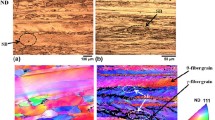Abstract
In our previous works, thin foils of boron-free stoichiometric Ni3Al, with thicknesses ranging from 57 to 315 µm, were fabricated by cold rolling of single-crystalline sheets which were sectioned from directionally solidified ingots. In this article, the room-temperature mechanical properties of the 83 and 95 pct cold-rolled foils were examined. Depending on the initial rolling direction, the foils exhibited two types of deformation microstructures: a banded structure with dual {110} textures and a band-free structure with a single {110} texture. The 83 pct cold-rolled foils showed very high Vickers hardness numbers: 649 and 604 for the banded and band-free structures, respectively. The foils possessed very high tensile fracture stress (1.7 to 2.0 GPa), with no appreciable plastic elongation along the rolling direction. The fracture stress of the 95 pct cold-rolled foils was slightly higher than that of the 83 pct cold-rolled foils. The banded-structure foils showed slightly higher fracture stress than the band-free-structure foils at the 83 pct reduction, but there was no difference between both the structures at the 95 pct reduction. Although there was no appreciable tensile elongation, slip traces were clearly observed on the surfaces of the foil specimens after the tensile test, indicating traces of some plastic deformation. The 95 pct cold-rolled foils possessed bending ductility, which was estimated as about 12 pct elongation on the tension-side surface of the bent specimen.
Similar content being viewed by others
References
N.S. Stoloff: Int. Mater. Rev., 1989, vol. 34, pp. 153–83.
K. Aoki and O. Izumi: Trans. JIM, 1978, vol. 19, pp. 203–10.
K. Aoki and O. Izumi: Nihon Kinzoku Gakkai Shi, 1979, vol. 43, pp. 1190–96.
C.T. Liu, C.L. White, and J.A. Horton: Acta Metall., 1985, vol. 33, pp. 213–29.
C.T. Liu and V.K. Sikka: J. Met., 1986, vol. 38, pp. 19–21.
T. Hirano: Acta Metall. Mater., 1990, vol. 38, pp. 2667–71.
T. Hirano: Scripta Metall. Mater., 1991, vol. 25, pp. 1747–50.
M. Demura, Y. Suga, O. Umezawa, K. Kishida, E.P. George, and T. Hirano: Intermetallics, 2001, vol. 9, pp. 157–67.
M. Demura, K. Kishida, O. Umezawa, K. Kishida, E.P. George, and T. Hirano: Proc. Mechanical Properties of Structural Films, Orlando, FL, 2000, ASTM, West Conshohocken, PA, 2001, pp. 248–61.
T. Hirano, M. Demura, K. Kishida, H.U. Hong, and Y. Suga: Proc. ISSI, 2001, vol. 3, pp. 765–74.
K. Kishida, M. Demura, T. Hirano, and Y. Suga: Proc. EUROMAT 2001, Rimini, 2001.
K. Kishida, M. Demura, T. Hirano, and Y. Suga: Proc. Fourth Pacific Rim Int. Conf. on Advanced Materials and Processing (PRICM 4), 2001, pp. 867–70.
K. Kishida, M. Demura, and T. Hirano: National Institute for Materials Science, Tsukuba, Ibaraki, Japan, unpublished research, 2001.
J.A. Wert, Q. Liu, and N. Hansen: Acta Mater., 1997, vol. 45, pp. 2565–76.
T. Taoka, E. Furubayashi, and S. Takeuchi: Trans. ISIJ, 1966, vol. 6, pp. 290–316.
J. Ball and G. Gottstein: Intermetallics, 1993, vol. 1, pp. 171–85.
T. Hirano and T. Kainuma: Iron Steel Inst. Jpn. Int., 1991, vol. 31, pp. 1134–38.
D. Golberg, M. Demura, and T. Hirano: Acta Mater., 1998, vol. 46, pp. 2695–2703.
M. Demura and T. Hirano: Phil. Mag. Lett., 1997, vol. 75, pp. 143–48.
P. Veyssiere and G. Saada: Dislocations in Solids, F.R.N. Nabarro and M.S. Duesbery, eds., Elsevier, Amsterdam, North-Holland, 1996, vol. 10, p. 263.
B.H. Kear and H.G.F. Wilsdorf: Trans. AIME, 1962, vol. 224, pp. 382–86.
S. Takeuchi and E. Kuramoto: Acta Metall., 1973, vol. 21, pp. 415–25.
T. Mawari and T. Hirano: Intermetallics, 1995, vol. 3, pp. 23–33.
T. Hirano, M. Demura, and D. Golberg: Acta Mater., 1999, vol. 47, pp. 3441–46.
C.D. Beachem: Fracture an Advanced Treatise, H. Liebowitz, ed., Academic Press, New York, NY, 1968, vol. 1, p. 332.
Author information
Authors and Affiliations
Rights and permissions
About this article
Cite this article
Demura, M., Kishida, K., Hirano, T. et al. Room-temperature mechanical properties of cold-rolled thin foils of binary, stoichiometric Ni3Al. Metall Mater Trans A 33, 2607–2613 (2002). https://doi.org/10.1007/s11661-002-0382-0
Received:
Issue Date:
DOI: https://doi.org/10.1007/s11661-002-0382-0




